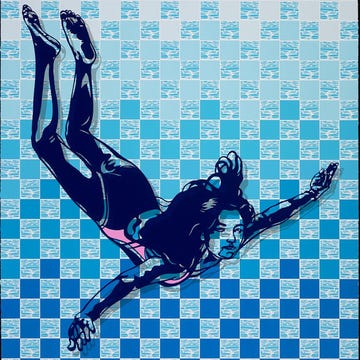Opening the Counterculture Museum, an institution devoted to progressive movements located on the corner of Haight and Ashbury in San Francisco, is both masterful marketing and real-estate luck. Formerly a Gap store, the roughly 4,200-square-foot space now contains books, posters, buttons, photographs, and other ephemera from the ’60s counterculture. Managers Jerry and Estelle Cimino, who also operate the Beat Museum in North Beach, promise a soft opening by the end of the month.
“In this city, we think about things locally, nationally, and internationally,” says Jerry. “The Counterculture Museum fits into all three categories. And I think [San Francisco] needs to remember why it’s influential…. So much has come from this town that has gone around the world.”
He’s not wrong. The Bay Area was a launchpad for ’60s counterculture, from mass-produced LSD to the Black Panthers, LGBTQ rights, the Summer of Love, psychedelic concert posters, and underground comics. The Ciminos’ goal is for visitors to soak up some of the era’s optimism and freedom of expression and return to their lives with a shred of renewed purpose.
The Ciminos’ Beat Museum, established in its present-day location in 2006, provided a blueprint for the Counterculture Museum. It’s personal and homemade, essentially a storefront with a bunch of stuff the managers collected. This new museum functions in a similar way, on a shoestring budget, funded largely by donors.
“Stuff lands on our doorstep,” Jerry says. “A guy walks in the door and says, ‘I’m 80 years old and I got a full Beat collection and my kids don’t want it. Can I give it to you?’ Hell, yeah, we’ll take it.”
The Counterculture Museum, a sleek building with freshly painted walls, tells history visually, through an eyeball assault of objet d’hippie from America’s most radically transformative decade. We begin a walking tour, and Jerry points out some white gallery-style display cases containing popular media technologies of the Beat era (newspapers, a transistor radio) and the hippie generation (a typewriter, a black-and-white television).
“We got these cases from the de Young Museum and the Legion of Honor. These were all donated to us,” he says.
Jerry steps into another room and gestures to more cases, of civil rights books and photos. He taps an image of Sammy Davis Jr. and Martin Luther King Jr. sharing a laugh and reads the MLK quote he plans to display alongside it: “Not everybody can be famous but everybody can be great, because greatness is determined by service.”
The museum’s main room will feature rotating exhibits. The inaugural show, The San Francisco Oracle, highlights the importance of alternative press during the hippie era. The exhibition will highlight The Oracle, which was published on Haight Street from 1966 to 1968, and will also include issues of the Realist, Berkeley Barb, and Rolling Stone. Covers of each publication will be framed and displayed on a white wall near posters for prominent 1967 events like the Human Be-In (a Golden Gate Park gathering in response to a ban on LSD) and the Houseboat Summit (an extended meeting in Sausalito discussing plans for a collective utopian future).
We keep moving, into a section of music ephemera, with one wall devoted to photographer Robert Altman’s images of ’60s rock stars like Janis Joplin, the Grateful Dead, and Grace Slick. Nearby, a display of the Chicago ’68 Democratic National Convention protests. A glass-enclosed table of feminist history, from “Women Power” buttons to the Chicago Women’s Liberation Union magazine Womankind. A case of anti-Nixon titles and bumper stickers. A plexi-cube exhibit about the Vietnam War, with books and news clips and a mannequin in military uniform. A cluster of books about punk rock. Mementos from the Haight Ashbury Free Clinic. Photos of Hunter S. Thompson. A 14-hour recording of one of Ken Kesey’s “acid tests.” A small stage, for book signings, readings, and panel discussions. And on and on. Jerry is an excellent guide, and although much of the history is familiar—photos of Jerry Garcia and the Dead, the “Hell no we won’t go!” button, the “Impeach Nixon” bumper sticker—the whole experience is quite concentrated and feels completely overwhelming.
“This isn’t ancient history,” Jerry explains. “We really thought [then] we could change the world. We still do. And that’s a big part of our message. We want to send people outta here with the idea that, Wow, these people did change the world in the ’60s and beyond. What can I do, as an 18-year-old or a 22-year-old, that can have an impact?”
The task seems massive, to explain the history of American counterculture. How does one define it? Do you include transcendentalism, the Chicano movement, the American Indian movement? The 1990s rave scene or hip-hop culture? Many museums are devoted to these subjects throughout the United States. If you want to deep-dive into civil rights history, or LGBTQ exhibits, or rock-and-roll displays, there are plenty of larger collections elsewhere.
But I’m willing to give this museum some leeway. The story the Ciminos tell comes without judgment or prejudice, and their hearts are in the right place. Opening a museum devoted to hippie history, with permanent exhibits, on the corner of Haight and Ashbury, is kind of genius. For decades, this sidewalk has seen a forever-changing yet magically self-replenishing string of retro-hippie nostalgia shops and boutiques. It’s essential that the neighborhood also features an organized repository where visitors can see the movement’s relics in proper context. This museum seems right at home.•
Counterculture Museum
1485 Haight St.
San Francisco
Jack Boulware runs the newsletter What Jack Boulware Fails to Realize. He was a cofounder and an executive director of San Francisco’s Litquake literary festival. He’s currently working on a novel based on his experiences as a travel journalist. He lives in West Marin.














